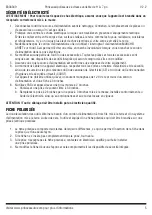
11 AMP 7 in. Variable Speed Polisher/Sander
6
For technical questions call: 1-800-665-8685
8336349
V 2.
2
POWER CORD
1. Insert the power cord plug directly to the power supply whenever possible.
a. Use extension cords or surge protectors only when the tool’s power cord cannot reach a power supply
from the work area (see below).
2. Do not operate this tool if the power cord is frayed or damaged as an electric shock may occur, resulting in
personal injury/death or damage the tool.
a. Inspect the tool’s power cord for cracks, fraying or other faults in the insulation or plug before each use.
b. Discontinue use if a power cord feels more than comfortably warm while operating the tool.
c. Take the following steps if either of the above situations occur:
i. Tag or mark the tool as ‘defective’ or ‘out of service’ until repaired.
ii. Contact an electrician or qualified person to replace the power cord.
3. Prevent damage to the power cord by observing the following:
a. Never use the cord to carry the tool.
b. Do not pull the plug from an outlet by the cord.
c. Keep the power cord clear of the tool and the tool’s work path while in operation. The cord should always
stay behind the tool.
d. Keep cord away from heat, oil, sharp edges or moving parts.
e. Do not allow people, mobile equipment or vehicles to pass over unprotected power cords.
i. Position power cords away from traffic areas.
ii. Place cords in reinforced conduits.
iii. Place planks on either side of the power cord to create a protective trench.
f. Do not wrap cord around tool as sharp edges may cut insulation or cause cracks if wound too tight.
Gently coil cord and either hang on a hook or fasten with a device to keep cord together when storing.
EXTENSION CORD
1. Never use an extension cord that doesn’t match or exceed the amperage rating of the tool. Using a cord that
is too long or an incorrect gauge could cause the following hazards:
a. Fire from overheating.
b. Electric shock from melting or damaging the cord’s insulation.
c. Under powering the tool causing a functional failure, resulting in personal injury or damage the tool.
d. A cord that is too long may create a hazard to others moving within the work area.
2. Use the tool without an extension cord whenever possible. Only use an extension cord as a temporary means
of reaching the power supply. Also unroll the cord completely to prevent it from overheating and damaging
the electrical insulation.
3. When operating a power tool outside, use an outdoor extension cord marked ‘W-A’ or ‘W’. These cords
are rated for outdoor use. They are constructed of more durable materials, and can withstand temperature
changes, UV light (sunlight) and moisture, reducing the risk of electric shock.
4. Use in conjunction with a Ground Fault Circuit Interrupter (GFCI). If operating a power tool in a damp
location is unavoidable, the use of a GFCI reduces the risk of electric shock. It is recommended that the GFCI
should have a rated residual current of 30 mA or less.







































